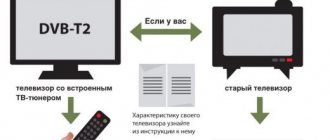July 24, 2021 Sergey Trikolenov
49 486
The television industry changes from year to year. Gone are the days when there was only cable television. Today you can choose from a large number of satellite, cable, fiber optic and Internet television providers. If you are not satisfied with your current supplier, then you can try something new.
Your home TV will always be tuned to your favorite shows, sports broadcasts, series and cartoons at a low price. Television providers are adding new options, for example, you can cheaply connect digital channels with an antenna and fast satellite Internet in 2021.
In order not to get confused by the variety of offers, we have compiled a rating of the TOP 5 best companies where you can connect television in Moscow at your home address. The list includes Moscow providers with high quality customer service, good channel packages and a free digital set-top box (DVB-T2).
MGTS
The Russian company MGTS offers to connect TV packages with Amedia series, MATCH! Football, Discovery, Children's and Adults. MGTS suggests using universal HD set-top boxes for digital television for home TV. This is better than other TV providers in our ranking, making the company one of the best in 2021.
Unfortunately, the MGTS provider is currently available only in Moscow and the Moscow region. They have a huge cable network coverage in the region (Reutov, Odintsovo, Vidnoye, Lyubertsy and Krasnogorsk). The cost of the cheapest tariff is only 160 rubles/month, and the largest set of channels costs 300 rubles/month.
Participate in the promotion and connect free TV and Internet for only 399 rubles/month. Additionally, you can order multiscreen, multiroom and personal online cinema from MGTS. Monitor your account status in your personal account on the website or download the MGTS application from the App Store or Google Play. This is fifth in the ranking of the best companies where you can connect TV in Moscow.
Go to MGTS
Sales and configuration of digital TV kits
We offer services for the sale and setup of equipment for receiving digital television and radio broadcasting. We remind you that from June 3, 2021, analogue terrestrial television broadcasting will be switched off throughout Russia. If you do not purchase and configure the entire set of equipment in a timely manner, you will not be able to watch federal television channels.
Advantages
The following benefits apply to you:
- Subscription fee is 0 rubles to watch high-quality TV in the digital standard. Russian TV viewers have access to 20 federal channels at once - watch your favorite news, entertainment, children's, sports, educational and other TV programs absolutely free.
- Large selection of kits. Set-top boxes for older TVs that do not support the DVB-T2 standard are available for sale separately. We have inexpensive equipment for reliable digital TV reception and models with the ability to defer viewing and recording to external media, Wi-Fi connection and watching TV over the Internet, support for child control and HDTV.
- Optional equipment. If your home does not have a connection to a collective antenna, then do not forget to purchase an individual antenna (indoor or for outdoor installation). An antenna is also necessary for modern TVs that support DVB-T2.
Akado
Connecting television to your home comes with some special features. First you need to check the possibility of connecting the apartment to the Akado cable network. Next, you need to choose a package with interactive channels to suit your needs: decide on the number of digital TV channels, and also test the services for free in the first month.
To connect, you will need a digital set-top box with an antenna; you can buy or rent it from your provider. The technician will come to your home at a convenient time and set up channel frequencies for free. For 100 rubles. per month you can get 70 basic FullHD quality channels. Other prices vary depending on the size of the package chosen. Akado uses modern network equipment and allows you to watch programs not only on TV, but also on smartphones based on Android and iOS.
The further you are from the urban areas of Moscow, the more difficult it is to find good cable television, but Akado satellite dishes will cope with this problem. Find out what other consumers think before you sign a monthly service agreement.
Go to Akado
Frequencies of DVB-T2 digital television channels in Russia and Moscow
The functionality of digital terrestrial television in Russia occurs at frequencies operating in the band from 470 to 862 MHz, on channels from 21 to 69. The regional DTV coverage area implies the choice of stream on which a digital set-top box or TV will be configured.
In the manual search option, you must enter the frequency of the desired channel.
| Channel no. | MHz. | Channel no. | MHz. | Channel no. | MHz. |
| 21 | 474 | 38 | 610 | 55 | 746 |
| 22 | 482 | 39 | 618 | 56 | 754 |
| 23 | 490 | 40 | 626 | 57 | 762 |
| 24 | 498 | 41 | 634 | 58 | 770 |
| 25 | 506 | 42 | 642 | 59 | 778 |
| 26 | 514 | 43 | 650 | 60 | 786 |
| 27 | 522 | 44 | 658 | 61 | 794 |
| 28 | 530 | 45 | 666 | 62 | 802 |
| 29 | 538 | 46 | 674 | 63 | 810 |
| 30 | 546 | 47 | 682 | 64 | 818 |
| 31 | 554 | 48 | 690 | 65 | 826 |
| 32 | 562 | 49 | 698 | 66 | 834 |
| 33 | 570 | 50 | 706 | 67 | 842 |
| 34 | 578 | 51 | 714 | 68 | 850 |
| 35 | 586 | 52 | 722 | 69 | 858 |
| 36 | 594 | 53 | 730 | — | — |
| 37 | 602 | 54 | 738 | — | — |
Table for setting up TV and set-top boxes with digital TV frequencies.
| № | Frequency, kHz | Modulation | Speed | № | Frequency, kHz | Modulation | Speed |
| 1 | 386000 /SK30 | 256-QAM | 6750 | 10 | 546000 /30TVK | 256-QAM | 6750 |
| 2 | 394000 /SK31 | 256-QAM | 6750 | 11 | 562000 /32TVK | 256-QAM | 6750 |
| 3 | 402000 /SK32 | 256-QAM | 6750 | 12 | 570000 /33TVK | 256-QAM | 6750 |
| 4 | 410000 /SK33 | 256-QAM | 6750 | 13 | 578000 /34TVK | 256-QAM | 6750 |
| 5 | 418000 /SK34 | 256-QAM | 6750 | 14 | 610000 /38TVK | 256-QAM | 6750 |
| 6 | 426000 /SK35 | 256-QAM | 6750 | 15 | 618000 /39TVK | 256-QAM | 6750 |
| 7 | 434000 /SK36 | 256-QAM | 6750 | 16 | 634000 /41TVK | 256-QAM | 6750 |
| 8 | 442000 /SK37 | 256-QAM | 6750 | 17 | 642000 /42TVK | 256-QAM | 6750 |
| 9 | 554000 /31TVK | 256-QAM | 6750 | — | — | — | — |
The necessary information about frequency data and coverage of individual regions is provided on the map
The service provides automatic detection of the region from which the page was entered.
Where is better
Where is the best place to look for a television provider in Moscow and the region? To do this, on the “Where is Better” website, in the empty field, indicate your residential address with the street name and house number. The system will analyze the possibility of connecting your apartment to interactive television with video rental, multiscreen and multiroom functions and will offer hundreds of popular channels along with the receiver (Carousel, Yu, Russia, 2x2 and MUZ-TV).
Choose one of the many television packages and leave a request for a free connection in Moscow. The company manager will contact you and answer all your questions. “Where is Better” will help you connect cable television and the Internet throughout Russia: Moscow region, St. Petersburg, Samara, Novosibirsk and Yekaterinburg.
The next day, an installer will come to you and carefully lay the cable through the apartment to the TV, receiver or set-top box. If you need television for your dacha or country house, the convenient “Where is Better” service will tell you where it is best to connect satellite television.
List of terrestrial television channels for 2021
The first group of programs, approved by decree of the President of Russia, includes federal channels. The second multiplex includes entertainment and informational-educational programs. The third multiplex is broadcast in test mode only from the Ostankino Tower (coverage radius up to 100 km), and the list of programs available for free viewing may change until they are finally approved.
| Logo | Number | Name | Genre | Frequency | Genre | Video format | Audio format |
| First multiplex | |||||||
| 30 | First | Federal | 546 MHz | Federal | MPEG4 | MPEG2 | |
| 30 | Russia 1 | Federal | 546 MHz | Federal | MPEG4 | MPEG2 | |
| 30 | Match | Federal | 546 MHz | Sport | MPEG4 | MPEG2 | |
| 30 | NTV | Federal | 546 MHz | Federal | MPEG4 | MPEG2 | |
| 30 | Petersburg 5 | Federal | 546 MHz | Federal | MPEG4 | MPEG2 | |
| 30 | Russia K | Federal | 546 MHz | Federal | MPEG4 | MPEG2 | |
| 30 | Russia 24 | News | 546 MHz | News | MPEG4 | MPEG2 | |
| 30 | Carousel | Children's | 546 MHz | Children's | MPEG4 | MPEG2 | |
| 30 | OTR | Public television of Russia | 546 MHz | Public television | MPEG4 | MPEG2 | |
| 30 | TV Center | Federal | 546 MHz | Federal | MPEG4 | MPEG2 | |
| 30 | Vesti FM | Radio | 546 MHz | Radio | MPEG4 | MPEG2 | |
| 30 | Lighthouse | Radio | 546 MHz | Radio | MPEG4 | MPEG2 | |
| 30 | Radio Russia | Radio | 546 MHz | Radio | MPEG4 | MPEG2 | |
| Second multiplex | |||||||
| 24 | REN TV | Federal | 498 MHz | 3/4 | MPEG4 | MPEG2 | |
| 24 | SAVED | Religion | 498 MHz | 3/4 | MPEG4 | MPEG2 | |
| 24 | STS | Entertaining | 498 MHz | 3/4 | MPEG4 | MPEG2 | |
| 24 | Home | Entertaining | 498 MHz | 3/4 | MPEG4 | MPEG2 | |
| 24 | TV3 | Entertaining | 498 MHz | 3/4 | MPEG4 | MPEG2 | |
| 24 | Friday | Entertaining | 498MHz | 3/4 | MPEG4 | MPEG2 | |
| 24 | Star | Historical | 498MHz | 3/4 | MPEG4 | MPEG2 | |
| 24 | WORLD | CIS channel | 498 MHz | 3/4 | MPEG4 | MPEG2 | |
| 24 | TNT | Movies | 498 MHz | 3/4 | MPEG4 | MPEG2 | |
| 24 | Muz TV | Music | 498 MHz | 3/4 | MPEG4 | MPEG2 | |
| Third multiplex (channels are broadcast according to schedule) | |||||||
| 34 | Sports 1 | Sport | 578 MHz | Around the clock | MPEG4 | MPEG2 | |
| 34 | Sports 2 | Sport | 578 MHz | 00:00-06:00 (42 hours/week) | MPEG4 | MPEG2 | |
| 34 | Fight club | Sport | 578 MHz | 06:00-12:00 (42 hours/week) | MPEG4 | MPEG2 | |
| 34 | My planet | Scientific and educational | 578 MHz | 12:00-18:00 (42 hours/week) | MPEG4 | MPEG2 | |
| 34 | Science 2.0 | Scientific and educational | 578 MHz | 18:00-00:00 (42 hours/week) | MPEG4 | MPEG2 | |
| 34 | Russian novel | Movies | 578 MHz | 00:00-05:00 (35 hours/week) | MPEG4 | MPEG2 | |
| 34 | Russian bestseller | Movies | 578 MHz | 05:00-10:00 (35 hours/week) | MPEG4 | MPEG2 | |
| 34 | Russian detective | Movies | 578 MHz | 10:00-15:00 (35 hours/week) | MPEG4 | MPEG2 | |
| 34 | Story | Scientific and educational | 578 MHz | 15:00 - 20:00 (35 hours/week) | MPEG4 | MPEG2 | |
| 34 | Cartoon | Children's | 578 MHz | 20:00-00:00 (35 hours/week) | MPEG4 | MPEG2 | |
| 34 | Sundress | Various | 578 MHz | 00:00-12:00 (84 hours/week) | MPEG4 | MPEG2 | |
| 34 | A country | Various | 578 MHz | 12:00-00:00 (84 hours/week) | MPEG4 | MPEG2 | |
| 34 | Living Planet | Scientific and educational | 578 MHz | 00:00-06:00 (42 hours/week) | MPEG4 | MPEG2 | |
| 34 | IQ HD | Informational | 578 MHz | 06:00-09:00 (21 hours/week) | MPEG4 | MPEG2 | |
| 34 | 24 Doc | Scientific and educational | 578 MHz | 09:00-12:00 (21 hours/week) | MPEG4 | MPEG2 | |
| 34 | Techno 24 | Scientific and educational | 578 MHz | 12:00-15:00 (21 hours/week) | MPEG4 | MPEG2 | |
| 34 | Mother | TV channel for mothers and children | 578 MHz | 15:00-18:00 (21 hours/week) | MPEG4 | MPEG2 | |
| 34 | NST | Movies | 578 MHz | 18:00-21:00 (21 hours/week) | MPEG4 | MPEG2 | |
| 34 | Amusement park | Entertaining | 578 MHz | 21:00-00:00 (21 hours/week) | MPEG4 | MPEG2 | |
| 34 | Moscow trust | Informational | 578 MHz | 00:00-12:00 (84 hours/week) | MPEG4 | MPEG2 | |
| 34 | euronews | News | 578 MHz | 12:00-00:00 (84 hours/week) | MPEG4 | MPEG2 | |
| 34 | Music of the first | Music | 578 MHz | 08:30-01:30 (119 hours/week) | MPEG4 | MPEG2 | |
| 34 | Home Cinema | Movies | 578 MHz | 01:30-02:30 (7 hours/week) | MPEG4 | MPEG2 | |
| 34 | Time | News | 578 MHz | 02:30-04:30 (14 hours/week) | MPEG4 | MPEG2 | |
| 34 | TV cafe | Entertaining | 578 MHz | 04:30-06:30 (14 hours/week) | MPEG4 | MPEG2 | |
| 34 | Beaver | Entertaining | 578 MHz | 06:30-08:30 (14 hours/week) | MPEG4 | MPEG2 | |
| 34 | 365 | Informational | 578 MHz | 00:00-02:00 (14 hours/week) | MPEG4 | MPEG2 | |
| 34 | TNT Comedy | Entertaining | 578 MHz | 02:00-04:00 (14 hours/week) | MPEG4 | MPEG2 | |
| 34 | Lots of TV | Movies | 578 MHz | 04:00-06:00 (14 hours/week) | MPEG4 | MPEG2 | |
| 34 | HD Life (SD quality) | Entertaining | 578 MHz | 06:00-08:00 (14 hours/week) | MPEG4 | MPEG2 | |
| 34 | Sports 1 | Various | 578 MHz | 08:00-10:00 (14 hours/week) | MPEG4 | MPEG2 | |
| 34 | India TV | Movies | 578 MHz | 10:00-12:00 (14 hours/week) | MPEG4 | MPEG2 | |
| 34 | Fighter | Sport | 578 MHz | 12:00-14:00 (14 hours/week) | MPEG4 | MPEG2 | |
| 34 | Comedy | Movies | 578 MHz | 14:00-16:00 (14 hours/week) | MPEG4 | MPEG2 | |
| 34 | La Minor | Music | 578 MHz | 16:00-18:00 (14 hours/week) | MPEG4 | MPEG2 | |
| 34 | Men's cinema | Movies | 578 MHz | 18:00-20:00 (14 hours/week) | MPEG4 | MPEG2 | |
| 34 | Kitchen TV | Entertaining | 578 MHz | 20:00-22:00 (14 hours/week) | MPEG4 | MPEG2 | |
| 34 | Auto Plus | Entertaining | 578 MHz | 22:00-00:00 (14 hours/week) | MPEG4 | MPEG2 | |
| 34 | Life News | News | 578 MHz | Around the clock | MPEG4 | MPEG2 | |
Beeline
If you are looking for where to connect inexpensive television in Moscow, Beeline has several cheap packages with TV channels. For 150 rubles. per month you get more than 200 channels in good quality (Match TV, Friday, STS, NTV and HBO), as well as free access to a database of thousands of popular films. Of course, you may have problems if several devices play high-quality video at the same time, but for one device this is the best option.
Unlike most Internet providers, a Beeline router can be purchased free of charge when signing a contract for more than 2.5 years. If you choose the “Starter” or “Bomb” tariff plan without a long-term contract, equipment rental will cost you an additional 150 rubles per month.
Connecting and distributing cables throughout the apartment is free. If you go on vacation, you don’t need to overpay for communications; block the Internet for up to 90 days. Beeline shows good results in the categories of “ease of service” and “cost of connection” - this is better than most providers in the TOP 10 rating.
Beeline promotional codes
The concept of DVB-T2 and its advantages
DVB-T2 is an abbreviation for digital video broadcasting, where the indicator “T” means over-the-air data transmission. The modular use of COFDM broadcasts channels in HD quality. It is possible to compress the video stream in MPEG-2 format and transfer data up to 31 Mb/s.
Compared to DVB-T, the new standard introduces:
- increase in multiplex channels;
- improving local TV broadcast performance;
- high definition performance;
- release of air frequencies.
There is nothing complicated in setting the frequencies of digital channels and it can be easily done independently. It is enough to use the data given in the tables.
5 / 5 ( 1 voice )
Pros and cons of a collective antenna
The main purpose of this type of receiver is to provide all residents of apartment buildings with digital TV. The collective antenna in Moscow allows you to configure all channels. It will become an effective analogue of an indoor TV antenna. Experts highlight the following advantages of this device:
- high quality reception. The collective TV antenna is installed by specialists, not by the residents of the house. They know the specific location of the area, so they choose the optimal point for installing the receiver;
- free service. The cost of antenna repair and installation is borne by the housing utility company;
- users will be able to simultaneously set up analogue and digital television. In the future, you can connect pay cable TV;
- A resident of an apartment building will be able to set up TV broadcasting immediately after arrival. No additional equipment required.
There is only one drawback - the subscription fee for use, which is initially included in utilities.
I want to know whether my television is analogue or digital?
Turn on the main central channels - Channel One, Rossiya 1, NTV, Channel Five, REN-TV, STS, TNT, Zvezda, TVC and others.
If you see the letter “A” next to the logos, then you have an analogue television, and you need to do a number of steps so that your TV can receive a digital signal.
If there is no "A" next to the logo, after April 15 you will be able to continue watching TV as before. The absence of the letter "A" means that :
- you initially have digital television (satellite or Internet TV);
- you have terrestrial television, but the transition to digital broadcasting has already been completed;
- Do you have cable TV? Moscow authorities have agreed with cable television operators to preserve analogue broadcasting on cable. But if you want, you can also switch to digital broadcasting in cable.
Please note : if you have multiple TVs in your home, they may receive TV signals in different ways. For example, in the living room the TV is connected to cable TV, and in the kitchen the reception is via an antenna.
Television tariffs for legal entities
“Super match” package
| Number of channels: 9 Cost: 450 rub./month |
| order more details |
Basic package
| Number of channels: 111 Cost: 65 0 rub./month |
| order more details |
Packages “For public broadcasting”
| Number of channels: 40 - 9 Cost: 1,300-4,500 rub./month |
| more details P.V. more details sportsorder |
What to do if your TV does not support digital format
If your TV does not support this format, you need to purchase additional equipment - a digital set-top box (receiver). If you have two TVs that you watch through an antenna, and you want to watch different channels on them, you need to purchase a set-top box for each of them. The digital set-top box needs to be connected to the TV and configured:
- Step 1: Turn off the TV's power.
- Step 2. Connect the antenna cable to the antenna input of the digital set-top box. Connect the video and audio cables to the appropriate jacks on your TV and set-top box. The image quality will be higher when connecting the set-top box to the TV with an HDMI cable.
- Step 3: Connect the power and turn on the TV.
- Step 4. From the menu, select the required input source: HDMI, AV, SCART and others.
- Step 5. Automatically search for digital TV programs using the operating instructions. You can perform a manual search. In this case, you must enter the channel number or frequency.
Where to go with questions about digital television, hotline?
If you have terrestrial TV, then you can find all the information about the transition to digital terrestrial television on the website of the Russian television and radio broadcasting network rtrs.rf (aka smotritsitru.rf) or consult with RTRS specialists by calling the hotline.
If you are a cable TV subscriber, contact your operator's support services.
You can also contact the Moscow Unified Information Service by phone. Video instructions on how to switch from analogue television to digital:
homyak:
08/17/2017 at 17:13
Irina Skripnikova, Yandex: “We will show regional TV channels to their original audience”
05/31/2017 > 17:04 Author: Zhdanov Alexey
In March of this year, one of the leaders of the Runet, Yandex, made a serious bid for leadership in the online video market: it began a test broadcast of TV channels 1 and 2 of multiplexes, as well as several niche channels, for its multi-million user audience. The head of the company’s video advertising development group, Irina Skripnikova, told Tele-Sputnik about the importance of the content of regional TV channels for the created Yandex video platform.
Which broadcasters and content owners are you interested in featuring on the video platform?
We are primarily interested in TV channels and rights holders whose content will be in demand by our audience. Including regional broadcasters. We would like the TV broadcasting network to be adapted for each user depending on their region, as is done in Yandex.TV Program.
Besides the regional aspect, are there other focuses in selecting TV content?
We conduct experiments and determine audience reactions to different television products. There is content that the user searches for himself - in search or on the Yandex.Video service, clearly formulating his request (“Next series”) or leaving it broad (“watch broadcast” or “TV online”). And there is passive consumption: on the main page, in our recommendation service “Zen” and in other Yandex projects, where we place “entry points” into video viewing and observe how the audience reacts to them. Now it is important for us to provide a variety of content in a variety of packaging, and then understand what is interesting to a specific audience. It is already clear how much work this is. At the moment we are at the stage of forming a content library.
What are the main models for monetizing video content?
First of all, we want to create a product for users, and then understand how to integrate monetization into it in a logical and non-intimidating way. Of course, we look at analogues on the Internet - on online broadcasts of TV channels 1 and 2 of multiplexes, thematic channels - and we see that common advertising models are not suitable for the Yandex audience. Take broadcasting on the Internet or delayed online viewing of some large TV channel: the user has already crossed the threshold of involvement, came for this content with a formed interest and is ready to watch 2 or 4 advertising pre-rolls in a row. In a situation where we collect various content and involve the user in watching it, the described approach will scare the viewer.
In your case, will the user switch from channel to channel more often and not want to watch pre-rolls every time?
Probably yes. Online TV viewing is different from traditional TV viewing. Habits and patterns of online video consumption are greatly influenced by the Internet media landscape. We continue full-scale experiments, so it’s too early to talk about a monetization model. It is important for us to take into account the interests of the user, on the one hand, and the rights holder and advertiser, on the other. We want to redefine the way online video advertising is done and make it more useful, relevant and less annoying.
Are the advertisements originally included in the TV program removed when broadcast on your platform?
No. If we are talking about a live broadcast, the stream cannot have “black windows” in advertising intervals.
Is the option of sharing TV channel advertising fees with you as a distribution channel being considered?
We are aware of the program to bring television advertising budgets to the digital environment. It is potentially possible to use this scheme.
Tell us about the regional principle of content selection. At what level will this happen - federal districts, regions, cities?
Technically, we can do very precise geographic targeting. We have projects in which we can target in large cities, for example in Moscow, right down to the district and sometimes to the street. The question is: how accessible will regional content be to us? Now, by offering federal channels, we actually have the Moscow “Orbit” and would really like to have these channels localized. If we have regional channels - Moscow, Kuban, Novosibirsk, Yekaterinburg - we will show them to the audience for which they were originally intended.
How interested are you in regional channels that are not selected for broadcasting on the 21st Button?
Now our network is built on the basis of the Yandex.TV program service. If the channel is present in this service, then it is technically easy for us to create its broadcast. If it is not registered in the “TV Programs” grid, then there is a longer path to its integration. But you also need to look at its content. If it broadcasts to a very narrow audience, for example, students at a regional university, you will have to weigh the labor costs of connecting it and the traffic that both we and the copyright holder will receive.
How would you structure the barriers to getting a regional TV channel onto your platform?
It is quite easy for us to connect a channel if it is already registered on one of the Internet broadcasting aggregators - Microimuls, Synterra Media, which collect signals from TV channels at the request of online platforms or at the request of the channels themselves. If a TV channel is not connected to an aggregator, then a technological barrier arises between us and the channel itself. Eliminating it requires costs, both time and financial.
What share of regional channels have already been transferred to aggregators?
I don't have this data. Now, when we ask to connect channels with which we have a contractual relationship, aggregators do this at our request.
Perhaps regional TV channels are being held back from connecting to aggregators by high fees?
In fact, it's not that much money. Aggregators make money not from TV channels, but from signal consumers.
Let's assume that the TV channel is on the aggregator platform. What might prevent it from appearing on your platform in this case?
Let's say there is a channel at the point where the online signal is distributed. In this case, it is important for us to obtain an accurate and detailed TV channel schedule. On the Internet, unlike traditional broadcasting, the user a priori has a need to watch not the content that is on air at a given second, but to be able to rewind it - watch from the beginning, watch those programs that he missed. Having an accurate schedule - down to the second - is critical in this case, and this is a problem that needs to be solved not only by regional channels, but also by large federal ones.
Why is it important?
The more detailed the grid description is, the more accurately we can configure the recommendation service. Critically important here are the exact start and end times of the program, a description of what is happening inside the program, its topic, participants, genre, planned audience, and a possible “black window” - that is, the impossibility of online broadcasting. We are looking to integrate with broadcast equipment manufacturers to make it easier for channels to prepare data for online use. It would be ideal for us if they were “sewn” into the broadcast stream by default. All this can be done. Another thing is that the channels still live in the old pre-online world and the need for such actions is not completely obvious to them.
Another component of the possible development of TV channels in the context of their online presence is content. It's no secret that the television audience is aging now. Young audiences are moving away from television to the Internet. We put a lot of effort into collecting analytics: what content is consumed by this or that audience and to what extent is it interesting to them. There is a myth that online audiences are only interested in clips, entertainment and UGC videos. This is not entirely true. We also see a high demand for serious online content: news and educational programs, and local video products. People want to see all this on those devices that are an integral part of their lives: on a computer or phone, which many do not part with either on weekdays or on weekends. This is a growing trend: TV channels come to us and conduct research together with Yandex - what series to launch, what broadcast format resonates with the audience. We have internal analytics, which we share and think about how to put this process on stream: provide an interface in which channels would get a more complete picture of their audience.
To what extent can this approach be scaled up at the level of regional channels with small audiences?
We have experience working with partners of the Yandex Advertising Network. These are tens of thousands of sites and for each one personal information is provided through an affiliate interface. Even for federal channels, the “manual” mode of interaction with Yandex is unviable, so for all channels - both federal and regional - we will set up receiving statistics about audiences through personal interfaces.
That is, in this case, the possibility of broadcasting on the Yandex platform is for a regional TV broadcaster a feedback channel about the needs of the online audience in order to increasingly adjust the content taking into account network broadcasting?
Yes, that's exactly what I meant. Let me clarify that the fact that young people watch less and less TV does not mean that people in the 25+ and even 50+ category watch little video online. Of course they do, and more and more.
There is a point of view expressed quite a long time ago: the upcoming shutdown of analogue broadcasting of RTRS will force regional channels that were not included in the “21st button” to make a massive transition to online broadcasting and, thus, they will all sooner or later come to online video. platforms - for example, to Yandex, as potentially the most widespread of them
Nowadays, all devices through which users consume video content are becoming increasingly smart and technologically advanced. Broadcasting needs to be adapted for each of them. The basic pattern of television viewing is changing, when the whole family gathers in front of the TV after a working day. People now want to consume content when it suits them, and consumption is becoming increasingly personalized. In the evening, in my family, for example, everyone goes away from their devices to relax. And everyone watches what interests them.
A familiar picture...
Joint viewings are becoming more significant and rare - for example, this is a pre-planned movie session or theater performance. And everyday video consumption becomes individual, to distract yourself, to be alone with yourself. Online is becoming the main medium for such video consumption.
But TV channels may not want to reach future digital audiences through large platforms like yours. They can make their own - with recommendations, catch ups, and a convenient grid.
We always consider the market in its competitive diversity. We are not the only large IT company in Russia, and this benefits all players: this is how the best products appear, because everyone is on their toes. If TV channels agree and create a centralized online platform for viewing their content, that’s great, we can only support them in this. But you need to understand that such a platform is a whole set of projects, a large complex. All these projects require time and quite expensive expertise - in the field of machine learning, distribution and processing of video distributed by CDN. TV channels will need to combine many technological layers to create such a platform. But the question still remains whether the TV channel will receive a response from the audience by going this route. For its part, Yandex is already offering a technological solution made at a high level by our specialists. And finally, we can offer TV channels the Yandex audience, which we are constantly studying.
Answer
The nuances of watching TV through a shared antenna
A collective antenna for digital television provides broadcasting of channels under the same contract as in the case of an individual connection. The intermediary is the housing company. The standard tariff plan, available to all subscribers, includes federal TV channels, as well as several regional programs.
As for paid channels, narrowly focused programs are mainly presented here - sports broadcasts, music videos, etc. An individual cable television connection allows you to select the set of necessary channels. The use of a collective antenna assumes that the subscriber selects one of the available paid tariffs.










